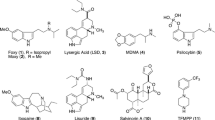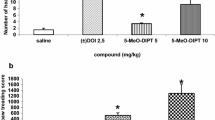Abstract
Rationale
Serotonin 5-HT2A and 5-HT2C receptors are thought to be the primary pharmacological mechanisms for serotonin-mediated hallucinogenic drugs, but recently there has been interest in metabotropic glutamate (mGluR2) receptors as contributors to the mechanism of hallucinogens.
Objective
The present study assesses the role of these 5-HT and glutamate receptors as molecular targets for two tryptamine hallucinogens, N,N-dimethyltryptamine (DMT) and N,N-diisopropyltryptamine (DiPT).
Methods
Drug discrimination, head twitch, and radioligand binding assays were used. A 5-HT2AR inverse agonist (MDL100907), 5-HT2CR antagonist (SB242084), and mGluR2/3 agonist (LY379268) were tested for their ability to attenuate the discriminative stimulus effects of DMT and DiPT; an mGluR2/3 antagonist (LY341495) was tested for potentiation. MDL100907 was used to attenuate head twitches induced by DMT and DiPT. Radioligand binding studies and inosital-1-phosphate (IP-1) accumulation were performed at the 5-HT2CR for DiPT.
Results
MDL100907 fully blocked the discriminative stimulus effects of DMT, but only partially blocked DiPT. SB242084 partially attenuated the discriminative stimulus effects of DiPT, but produced minimal attenuation of DMT’s effects. LY379268 produced potent, but only partial blockade of the discriminative stimulus effects of DMT. LY341495 facilitated DMT- and DiPT-like effects. Both compounds elicited head twitches (DiPT>DMT) which were blocked by MDL1000907. DiPT was a low-potency full agonist at 5-HT2CR in vitro.
Conclusions
The 5-HT2AR likely plays a major role in mediating the effects of both compounds. 5-HT2C and mGluR2 receptors likely modulate the discriminative stimulus effects of both compounds to some degree.





Similar content being viewed by others
References
Appel JB, West WB, Rolandi WG, Alici T, Pechersky K (1999) Increasing the selectivity of drug discrimination procedures. Pharmacol Biochem Behav 64:353–358
Canal CE, Olaghere da Silva UB, Gresch PJ, Watt EE, Sanders-Bush E, Airey DC (2010) The serotonin 2C receptor potently modulates the head-twitch response in mice induced by a phenethylamine hallucinogen. Psychopharmacology (Berl) 209:163–174
Carbonaro T, Forster MJ, Gatch MB (2013) Discriminative stimulus effects of N, N-diisopropyltryptamine. Psychopharmacology (Berl) 226:241–246
Cartmell J, Monn JA, Schoepp DD (1999) The metabotropic glutamate 2/3 receptor agonists LY354740 and LY379268 selectively attenuate phencyclidine versus d-amphetamine motor behaviors in rats. J Pharmacol Exp Ther 291:161–170
Cozzi NV, Gopalakrishnan A, Anderson LL, Feih JT, Shulgin AT, Daley PF, Ruoho AE (2009) Dimethyltryptamine and other hallucinogenic tryptamines exhibit substrate behavior at the serotonin uptake transporter and the vesicle monoamine transporter. J Neural Transm 116:1591–1599
Delille HK, Becker JM, Burkhardt S, Bleher B, Terstappen GC, Schmidt M, Meyer AH, Unger L, Marek GJ, Mezler M (2012) Heterocomplex formation of 5-HT2A-mGlu2 and its relevance for cellular signaling cascades. Neuropharmacology 62:2184–2191
Eshleman AJ, Forster MJ, Wolfrum KM, Johnson RA, Janowsky A, Gatch MB (2014) Behavioral and neurochemical pharmacology of six psychoactive substituted phenethylamines: mouse locomotion, rat drug discrimination and in vitro receptor and transporter binding and function. Psychopharmacology (Berl) 231:875–888
Fantegrossi WE, Harrington AW, Kiessel CL, Eckler JR, Rabin RA, Winter JC, Coop A, Rice KC, Woods JH (2006) Hallucinogen-like actions of 5-methoxy-N, N-diisopropyltryptamine in mice and rats. Pharmacol Biochem Behav 83:122–129
Forsythe ID, Barnes-Davies M (1997) Synaptic transmission: well-placed modulators. Curr Biol 7:R362–R365
Gatch MB, Rutledge MA, Carbonaro T, Forster MJ (2009) Comparison of the discriminative stimulus effects of dimethyltryptamine with different classes of psychoactive compounds in rats. Psychopharmacology (Berl) 204:715–724
Gatch MB, Forster MJ, Janowsky A, Eshleman AJ (2011) Abuse liability profile of three substituted tryptamines. J Pharmacol Exp Ther 338:280–289
Glennon RA (1986) Discriminative stimulus properties of phenylisopropylamine derivatives. Drug Alcohol Depend 17:119–134
Glennon RA, Young R, Jacyno JM, Slusher M, Rosecrnas JA (1983) DOM-stimulus generalization to LSD and other hallucinogenic indolealkylamines. Eur J Pharmacol 86:453–459
Gonzalez-Maeso J, Weisstaub NV, Zhou M, Chan P, Ivic L, Ang R, Lira A, Bradley-Moore M, Ge Y, Zhou Q, Sealfon SC, Gingrich JA (2007) Hallucinogens recruit specific cortical 5-HT(2A) receptor-mediated signaling pathways to affect behavior. Neuron 53:439–452
Gonzalez-Maeso J, Ang RL, Yuen T, Chan P, Weisstaub NV, Lopez-Gimenez JF, Zhou M, Okawa Y, Callado LF, Milligan G, Gingrich JA, Filizola M, Meana JJ, Sealfon SC (2008) Identification of a serotonin/glutamate receptor complex implicated in psychosis. Nature 452:93–97
Helsley S, Fiorella D, Rabin RA, Winter JC (1998) A comparison of N,N-dimethylamine, harmaline, and selected congeners in rats trained with LSD as a discriminative stimulus. Prog Neuropsychopharmacol Biol Psychiatry 22:649–663
Jarbe TUC (1980) LSD-25 as a discriminative stimulus for response selection by pigeons. Pharmacol Biochem Behav 13:549–554
Knight AR, Misra A, Quirk K, Benwell K, Revell D, Kennett G Bickerdike M (2004) Pharmacological characterisation of the agonist radioligand binding site of 5-HT(2A), 5-HT(2B) and 5-HT(2C) receptors. Naunyn Schmiedebergs Arch Pharmacol 370:114–123
Lyon RA, Titeler M, Seggel MR,Glennon RA (1988) Indolealkylamine analogs share 5-HT2 binding characteristics with phenylalkylamine hallucinogens. Eur J Pharmacol 145:291–297
Moreno JL, Holloway T, Albizu L, Sealfon SC, González-Maeso J (2011) Metabotropic glutamate mGlu2 receptor is necessary for the pharmacological and behavioral effects induced by hallucinogenic 5-HT2A receptor agonists. Neurosci Lett 493:76–79
Nagai F, Nonaka R, Satoh K, Kamimura H (2007) The effects of non-medically used psychoactive drugs on monoamine neurotransmission in rat brain. Eur J Pharmacol 559:132–137
National Research Council (2003) Guidelines for the care and use of mammals in neuroscience and behavioral research. The National Academies Press, Washington, DC
Nichols DE (2004) Hallucinogens. Pharmacol Ther 101:131–181
Ohishi H, Ogawa-Meguro R, Shigemoto R, Kaneko T, Nakanishi S, Mizuno N (1994) Immunohistochemical localization of metabotropic glutamate receptors, mGluR2 and mGluR3, in rat cerebellar cortex. Neuron 13:55–66
Pierce PA, Peroutak SJ (1989) Hallucinogenic drug interaction with neurotransmitter receptor binding sites in human cortex. Psychopharmacol (Berl) 97:188–122
Shigemoto R, Kinoshita A, Wada E, Nomura S, Ohishi H, Takada M, Flor PJ, Neki A, Abe T, Nakanishi S, Mizuno N (1997) Differential presynaptic localization of metabotropic glutamate receptor subtypes in the rat hippocampus. J Neurosci 17:7503–7522
Shulgin AT, Carter MF (1980) N, N-Diisopropyltryptamine (DIPT) and 5-methoxy-N, N-diisopropyltryptamine (5-MeO-DIPT). Two orally active tryptamine analogs with CNS activity. Commun Psychopharmacol 4:363–369
Shulgin AT, Shulgin A (1997) TiHKAL. Transform Press, Berkeley
Smith RL, Canton H, Barrett RJ, Sanders-Bush E (1998) Agonist properties of N, N-dimethyltryptamine at serotonin 5–HT2A and 5–HT2C receptors. Pharmacol Biochem Behav 61:323–330
Stoff DM, Moja EA, Gillin JC, Wyatt RJ (1977) Dose response and time course effects of N, N-dimethyltryptamine on disruption of rat shuttlebox avoidance. Biol Psychiatry 12:339–346
Strassman RJ, Qualls CR (1994) Dose-response study of N, N-dimethyltryptamine in humans. I. Neuroendocrine, autonomic, and cardiovascular effects. Arch Gen Psychiatry 51:85–97
Strassman RJ, Qualls CR, Uhlenhuth EH, Kellner R (1994) Dose-response study of N, N-dimethyltryptamine in humans. II. Subjective effects and preliminary results of a new rating scale. Arch Gen Psychiatry 51:98–108
Strassman RJ, Qualls CR, Berg LM (1996) Differential tolerance to biological and subjective effects of four closely spaced doses of N, N-dimethyltryptamine in humans. Biol Psychiatry 39:784–795
Winter JC, Eckler JR, Rabin RA (2004) Serotonergic/glutamatergic interactions: the effects of mGlu2/3 receptor ligands in rats trained with LSD and PCP as discriminative stimuli. Psychopharmacology (Berl) 172:233–240
Funding
Funding was provided by the Addiction Treatment Discovery Program of the National Institute on Drug Abuse (NIH N01DA-7-8872) and by T32 AG020494. A portion of this work was supported by the Intramural Research Programs of the National Institute on Drug Abuse and National Institute on Alcohol Abuse and Alcoholism. There are no conflicts of interest.
Author information
Authors and Affiliations
Corresponding author
Rights and permissions
About this article
Cite this article
Carbonaro, T.M., Eshleman, A.J., Forster, M.J. et al. The role of 5-HT2A, 5-HT2C and mGlu2 receptors in the behavioral effects of tryptamine hallucinogens N,N-dimethyltryptamine and N,N-diisopropyltryptamine in rats and mice. Psychopharmacology 232, 275–284 (2015). https://doi.org/10.1007/s00213-014-3658-3
Received:
Accepted:
Published:
Issue Date:
DOI: https://doi.org/10.1007/s00213-014-3658-3




